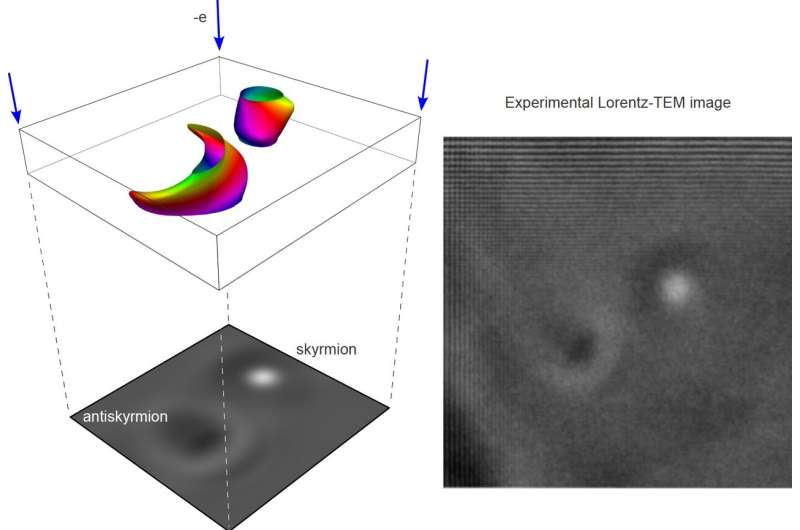Left: Skyrmion-antiskyrmion pair predicted using micromagnetic simulations and a corresponding simulated Lorentz TEM image in the over-focus regime. The isosurfaces correspond to the positions of magnetization vectors lying in the plane of the film. The color indicates the direction of the magnetization vectors in the plane. Right: Experimental Lorentz TEM image of a skyrmion-antiskyrmion pair recorded under the same conditions as the simulated image. The bright and dark spots correspond to a skyrmion and an antiskyrmion, respectively. Credit: Zheng et al.
Matching particles and antiparticles are small units of matter that have the same mass but opposite electric charges. Typically, these units of matter with opposite electric charge tend to annihilate one another.
Studies have predicted that the same behavior should also be observed in magnetic solitons with opposing topological charges. Magnetic solitons, or solitary waves, are localized spin textures that maintain their shape while propagating at a constant velocity and can be distinguished by their topological charge Q.
Based on theoretical predictions, magnetic solitons with opposite Q values should continuously merge and annihilate themselves. This includes skyrmions and antiskyrmions, swirling topological magnetic textures that are realized as emergent particles in magnets.
Researchers at Forschungszentrum Jülich and JARA in Germany in cooperation with KTH Stockholm and Uppsala University in Sweden have recently carried out one of the first experiments aimed at testing these predictions. Their paper, published in Nature Physics, demonstrates the creation and annihilation of skyrmion-antiskyrmion pairs in a cubic chiral magnet.
"Over the last few years, we have intensively studied magnetic solitons in chiral magnets with the aim to reveal their particle-like properties," Nikolai Kiselev, one of the researchers who carried out the study, told Phys.org. "The most well-known type of soliton in these materials is a magnetic chiral skyrmion. We have accumulated extensive experience in the study of a particular alloy of FeGe, which is a representative example of a rich family of chiral magnets with a B20-type crystal structure."
Initially, Kiselev and his colleagues set out to observe skyrmion bags—exotic magnetic solitons with an arbitrary topological charge, which have been predicted in prior theoretical work. For this experiment, the researchers fabricated an ultra-thin film of the cubic chiral magnet FeGe.
While conducting their experiments, however, the researchers unveiled other interesting phenomena, which they ultimately found to be associated with skyrmion antiparticles. In their new study, they used a technique known as transmission electron microscopy (TEM), which is the most established technique for in situ observation and imaging of magnetic textures in samples that are up to a few hundred nanometers thick.
"The incident electron beam that travels through the sample interacts with the magnetic field that results from local variations in magnetization in the sample, allowing magnetic contrast to be recorded with nanometer spatial resolution," Kiselev explained. "The distinct magnetic contrast of skyrmions and antiskyrmions allowed us to distinguish these particles, as well as the process of their creation and annihilation."
As researchers explain, one of the key ingredients behind successful observation of antiskyrmions was their use of an exceptionally thin and high quality FeGe plate (i.e., 1 μm x 1 μm square plate of only 70 nm in thickness). This sample had been prepared using a technique known as focused ion beam milling.
The shape of the sample is important and enhances the formation of "closed" domain walls at the edges of the sample. The latter is a prerequisite for the nucleation of antiskyrmions under the application to the sample of an external magnetic field.
"Prior to our work, it was commonly assumed that skyrmions and antiskyrmions could not coexist in cubic chiral magnets," Kiselev said. "However, our theoretical and experimental work proves that it is indeed possible. The possibility that skyrmions and antiskyrmions can coexist over a wide range of temperatures and applied magnetic fields was overlooked in earlier theoretical studies, including our own."
The findings gathered by this team of researchers could inspire more studies of magnetic solitons of different topological charges and symmetry which was not known before. In the future, such a diversity of particle-like states may pave the way toward new strategies to use magnetic solitons in spintronic devices.
To explore these strategies, however, the researchers will first need to conduct systematic studies of physical properties magnetic solitons and find or synthesize new materials in which magnetic solitons are present at ambient conditions.
"Our work suggests the existence of a wide diversity of solitons that have not been observed experimentally so far," Kiselev added. "We now plan to find a reliable protocol to gather experimental observations of exotic solitons such as skyrmion bags and other three-dimensional solitons that are known as hopfions. Preliminary studies show that the observation of such exotic solitons should be feasible in FeGe and other materials of this class."
More information: Fengshan Zheng et al, Skyrmion–antiskyrmion pair creation and annihilation in a cubic chiral magnet, Nature Physics (2022). DOI: 10.1038/s41567-022-01638-4
Filipp N. Rybakov et al, Chiral magnetic skyrmions with arbitrary topological charge, Physical Review B (2019). DOI: 10.1103/PhysRevB.99.064437
Journal information: Nature Physics , Physical Review B
© 2022 Science X Network
























